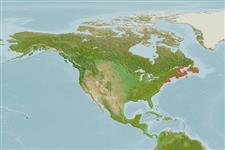Actinopterygii (ray-finned fishes) >
Gasterosteiformes (Sticklebacks and seamoths) >
Gasterosteidae (Sticklebacks and tubesnouts)
Etymology: Apeltes: Greek, a = without + Greek, pelte = shield (Ref. 45335).
Environment / Climate / Range
Ecology
Marine; freshwater; brackish; benthopelagic; depth range 0 - 3 m (Ref. 85409). Temperate; 4°C - 20°C (Ref. 2059), preferred ?; 51°N - 35°N
Western Atlantic: Gulf of St. Lawrence in Canada to North Carolina, USA. Mainly a near-shore marine species, but far inland populations occur in lakes in Nova Scotia in Canada and in Hudson, Delaware and Susquehanna River drainages (Ref. 5723).
Size / Weight / Age
Maturity: Lm ? range ? - ? cm
Max length : 6.4 cm TL male/unsexed; (Ref. 5723); common length : 4.1 cm TL male/unsexed; (Ref. 12193); max. reported age: 3 years (Ref. 12193)
Adults occur mainly along weedy bays and backwaters, entering brackish water and to a limited extent, fresh water (Ref. 3814). Feed along the bottom, primarily on diatoms, worms and crustaceans by sucking in the prey with a pipetting action (Ref. 27549). Males build, guard and aerate the nest where the eggs are deposited (Ref. 205).
Life cycle and mating behavior
Maturity | Reproduction | Spawning | Eggs | Fecundity | Larvae
The male builds, guards and aerates the nest (Ref. 205).
Robins, C.R., R.M. Bailey, C.E. Bond, J.R. Brooker, E.A. Lachner, R.N. Lea and W.B. Scott, 1991. Common and scientific names of fishes from the United States and Canada. Am. Fish. Soc. Spec. Pub. (20):183 p. (Ref. 3814)
IUCN Red List Status (Ref. 115185)
CITES (Ref. 94142)
Not Evaluated
Threat to humans
Harmless
Human uses
Aquarium: public aquariums
More information
ReferencesAquacultureAquaculture profileStrainsGeneticsAllele frequenciesHeritabilityDiseasesProcessingMass conversion
Tools
Special reports
Download XML
Internet sources
